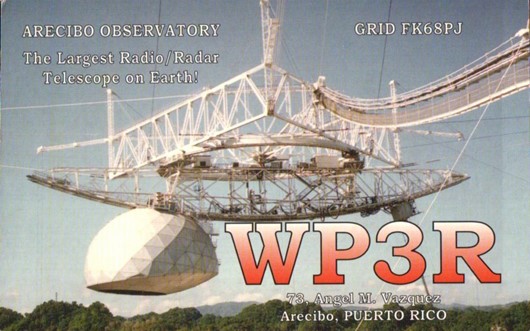The iconic radio telescope at the Arecibo Observatory in Puerto Rico—a site near and dear to amateur radio operators the world over—will not be repaired or rebuilt, the National Science Foundation (NSF) announced in October.
A little more than two years ago on December 1, 2020, the 900-ton instrument platform of the Arecibo Observatory’s radio telescope broke from its support cables and crashed into its 1,000-foot aluminum spherical reflector dish, leaving a 100-foot crater in the dish and damaging the Gregorian dome above. Even before the events of December 1, the NSF had decommissioned the telescope due to safety concerns. While acknowledging the telescope’s significance to the scientific community, NSF representatives said the decision to forego a rebuild came, in part, because the U.S. now has radar facilities that can perform some of what was accomplished at Arecibo.
In lieu of rebuilding the telescope, the NSF plans to construct a facility there to promote STEM programs and partnerships.
Despite the decision not to rebuild, the telescope will live on through its contributions to the field of astrophysics, observation of asteroids (see below), Hollywood cameos in movies like GoldenEye and Contact, and amateur radio-related activities, including ionospheric research and the observatory’s roll in the historic moon-bounce event of April 2010.
On November 16, 1974, the observatory’s telescope beamed the first intentional radio signal into space with the goal of contacting alien life—a QSO that has yet to be achieved. The three-minute transmission was sent as a pattern of binary numbers to a globular star cluster on the fringes of the Milky Way, about 21,000 light-years from Earth. Known as the “Arecibo Message,” it contained information about Earth’s location, the basic chemicals of life, DNA structure, and a Frankenstein’s-monster-like figure of a human, kind of like what you’d find in an early 2-bit Atari game. Below is a pictorial representation of the message with color added:

Take a moment to watch this video of Tim Duffy, K3LR, DX Engineering CEO, interviewing Angel Vazquez, WP3R, who was head of telescope operations at the time of the collapse. Below is WP3R’s QSL card featuring the telescope:

Parting Gifts from the Telescope
The Arecibo Observatory was in the news again when scientists released a trove of data regarding near-Earth asteroids collected from Arecibo between December 2017 and December 2019. A report on these asteroids (none of which pose an immediate Armageddon-style threat to Earth, per NASA) was published in September in The Planetary Science Journal.
From the report’s abstract: “We successfully observed 191 near-Earth asteroids using the Arecibo Observatory’s S-band planetary radar system from 2017 December through 2019 December. We present radar cross sections for 167 asteroids; circular-polarization ratios for 112 asteroids based on Doppler-echo-power spectra measurements; and radar albedos, constraints on size and spin periods, and surface-feature and shape evaluation for 37 selected asteroids using delay-Doppler radar images with a range resolution of 75 m or finer.”
And noted in the report’s introduction: “Earth-based planetary radar observations are a unique, cost-effective tool for post-discovery characterization of near-Earth asteroids (NEAs). Optical observations enable the discovery of the majority of asteroids and track them across the plane of sky over days or weeks in order to refine their orbital elements.”
As reported by Space.com, such research is valuable for planetary defense efforts (several “potentially hazardous” asteroids were found) as well as in researching the evolution of the solar system and, perhaps, future mining of asteroids. We may not have heard the last from Arecibo as researchers continue to analyze collected data.

